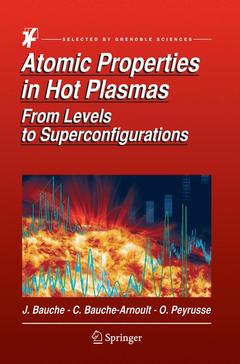Description
Atomic Properties in Hot Plasmas, Softcover reprint of the original 1st ed. 2015
From Levels to Superconfigurations
Authors: Bauche Jacques, Bauche-Arnoult Claire, Peyrusse Olivier
Language: English
Subject for Atomic Properties in Hot Plasmas:
Approximative price 105.49 €
In Print (Delivery period: 15 days).
Add to cartPublication date: 10-2016
Support: Print on demand
Approximative price 105.49 €
In Print (Delivery period: 15 days).
Add to cartPublication date: 08-2015
379 p. · 15.5x23.5 cm · Hardback
Description
/li>Contents
/li>Biography
/li>Comment
/li>
This book is devoted to the calculation of hot-plasma properties which generally requires a huge number of atomic data. It is the first book that combines information on the details of the basic atomic physics and its application to atomic spectroscopy with the use of the relevant statistical approaches. Information like energy levels, radiative rates, collisional and radiative cross-sections, etc., must be included in equilibrium or non-equilibrium models in order to describe both the atomic-population kinetics and the radiative properties. From the very large number of levels and transitions involved in complex ions, some statistical (global) properties emerge.
The book presents a coherent set of concepts and compact formulas suitable for tractable and accurate calculations. The topics addressed are: radiative emission and absorption, and a dozen of other collisional and radiative processes; transition arrays between level ensembles (configurations, superconfigurations); effective temperatures of configurations, superconfigurations, and ions; charge-state distributions; radiative power losses and opacity. There are many numerical examples and comparisons with experiment presented throughout the book. The plasma properties described in this book are especially relevant to large nuclear fusion facilities such as the NIF (California) and the ITER (France), and to astrophysics.
Methods relevant to the central-field configurational model are described in detail in the appendices: tensor-operator techniques, second-quantization formalism, statistical distribution moments, and the algebra of partition functions. Some extra tools are propensity laws, correlations, and fractals. These methods are applied to the analytical derivation of many properties, specially the global ones, through which the complexity is much reduced. The book is intended for graduate-level students, and for physicists working in the field.
Preface.- Abbreviations.- Introduction.- The Central-Field Configurational Model.- Distribution Functions. Energy Levels.- Statistical Properties of Transition Arrays.- Modeling of Ionic Spectra.- Static and Dynamical Equilibrium in Plasmas.- Super Configurations and Super Transition Arrays.- Global Approach to Plasmas in LTE Equilibrium.- Global Approaches to Non-LTE Hot Dense Plasmas. Effective Temperatures.- Hybrid Models.- Plasma Simulations.- Applications to Hot-Plasma Radiation.- Appendix A – The Tensor-Operator Formalism.- Appendix B – The Second-Quantization Method for Electrons in Atoms.- Appendix C – Partition Function Algebra.- Appendix D – Analytical Evaluation of the Ionic-Excitation Temperature T(I).- Appendix E – Evaluation of the Radiative Power Losses of a Superconfiguration.- Subject index.
Claire Bauche-Arnoult, is a retired assistant professor, also of the Université Paris Sud, Orsay, France.
Olivier Peyrusse, is a physicist in the French Bureau of Atomic Energy (CEA) and currently affiliated to the Laboratoire Centre Lasers Intenses et Applications (CELIA), Université de Bordeaux, Talence, France.
Introduces statistical methods in the quantum mechanical treatment of hot plasmas
Analyzes the global properties of level ensembles, such as configurations, superconfigurations, ions
Illustrates correlations between line intensities and wavenumbers, useful for radiative transfer
Offers both rigorous fundamental atomic physics and well-illustrated applications to current problems in atomic spectroscopy



